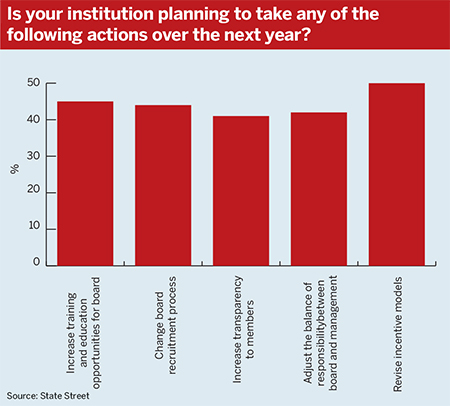Efforts to cope with a combination of market volatility and demographic shift towards an older population are causing pension schemes to re-examine and improve their governance structures, research from State Street this week showed.
The increasing complexity of the pensions industry has led to questions about how schemes are governed, especially considering the role of lay trustees.
Regulatory change is only one of the drivers for better governance
Ian Hamilton, State Street
The report, entitled 'Pensions with Purpose', surveyed 400 pension industry senior executives across 20 countries. It found 92 per cent of respondents planned to upgrade at least one part of their governance in 2016.
The report stated: “Strong governance is key to pension funds executing on their strategies and realising the outcomes required by members. The vast majority will need to adapt their existing governance models – at least in part – if they are to fulfill their objectives.”
It laid out a five-part plan to handle the changes schemes face. It consisted of ensuring the scheme had good governance systems, a model to suit their needs, increased risk-management capabilities, consolidation to save costs while improving efficiency, and balancing in-house and outsourced investment capabilities.
Changes planned...

The high percentage of funds planning to make changes reflects unease about the perceived gaps in board capabilities. General investment literacy was perceived to be at a high level on only 38 per cent of boards, while understanding of risks facing the fund was at 36 per cent and an ability to think beyond short-term issues was just 32 per cent.
...around perceived weaknesses

Ian Hamilton, head of asset owner sales at State Street, said the findings reflected the increased demands on trustees.
He said: “The role of the trustee is becoming more complex with the increasing breadth of investment opportunities, the esoteric nature of asset classes and the sophistication of derisking strategies… They recognise the need to maximise the effectiveness of their boards at a time when best practice governance and decision-making are critical.”
Hamilton added that regulatory change is only one of the drivers for better governance.
“In our interaction with clients, the drive for demonstrable best practice, the desire to be market-leading versus their peers, and the focus on managing reputational risk and personal diligence are all drivers in ensuring governance is a priority for trustees.”
However, Richard Butcher, managing director at professional trustee company PTL, said changes to regulations governing pensions was a key driver in governance change.
“We’re having to consider the investment structure to make sure it’s consistent with freedom and choice,” he said. “In defined benefit it’s more around trying to assess whether the members want access to freedom and choice.”
“You can see that retirement is becoming increasingly difficult to afford. Where it becomes less attainable there’s always going to be an attempt to provide efficiency.”
But Butcher admitted that his experience with trustee boards was skewed towards those more likely to be proactive. “The boards I’m exposed to are by definition self-selecting, so we’re always seeking to improve what we do.”
Purpose of the board
Avgi Gregory, director at governance specialist Muse Advisory, said there was a much greater drive towards assessing and improving scheme governance.
She pointed out that the company was this year conducting more board effectiveness reviews than ever before. The previous six months have also been the busiest for governance reviews.
She said: “Being a trustee is quite challenging these days, and it’s time there was more clarity on the purpose of the board.”
Gregory added: “It’s those trustees that are well governed that want to be better governed. Those that have some challenges have, until now, kept their head in the sand.”














